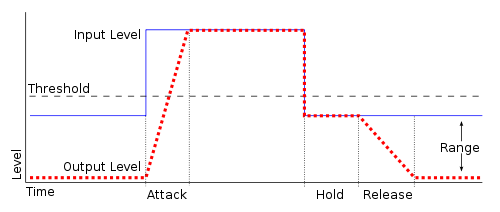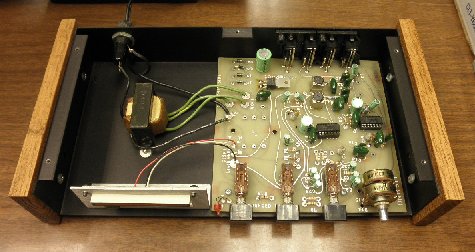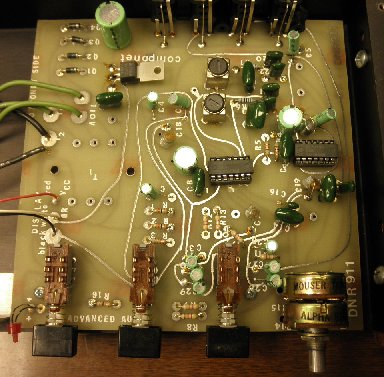Enter Dynamic Noise Reduction
What if you could devise a "perfect" noise reduction system that could work anywhere, with almost any type of source, even one that wasn't pre-encoded?
Dynamic Noise Reduction works differently from the other noise reduction systems described above. It is a playback only system, meaning that no pre-encoding is required or even possible.
Although Wikipedia's article on the subject claims that Dynamic Noise Reduction (hereafter referred to as DNR, at least most of the time) was based on the non-patented Philips Dynamic Noise Limiter system, I'm not sure how true this is. National Semiconductor produces an integrated circuit that offers the DNR system and its datasheet discusses two (now expired) patents: # 3,678,416 and # 3,753,159. Although the patent landscape is different today than it used to be (and subject to much more abuse in recent times), I'm reasonably sure that anyone who came up with a system as potentially game-changing as the DNR or DNL systems could be, would have protected it with a patent.
Various National Semiconductor documents discussing the DNR system claim that its use is royalty free, an interesting circumstance for a system that utilized patented technologies.
The patents, both issued to Richard Burwen, describe the system in "legalese".
What and How
As already mentioned, DNR does not require pre-processing or encoding of the source material. In theory, it can be applied to any audio source in need of noise reduction at any time. In its most common implementation, DNR functionality is supplied by the LM1894 IC. An LM832 (more suitable for low level signals as might be found in "portable equipment", though it could possibly be used in a phono preamplifier stage) was also produced.
If you have the time, I'd recommend stopping right now and reading National Semiconductor's application notes for DNR, specifically AN-384, AN-386 and AN-390. These are very well written and reasonably understandable documents that explain what is going on, as well as the issues faced and how they are mitigated. Some of this document is based on those, or on material contained in those documents, so please do read them if you can make the time to do so. (I was recently alerted to these links having decayed, and have since repaired them accordingly. Thanks, Kevin!)
What the DNR system does is to reduce certain types of noise, particularly hiss from tapes.
How it does this is very simple, yet extremely clever at the same time. There are a few different things going on here. Let's talk about each one.
First, and most simply, the DNR system is a variable low-pass filtering system with a fast attack time. A low-pass filter is used to filter out everything above its set point, and a high-pass filter does exactly the opposite. "Attack" refers to how quickly the system can disengage and cancel its filtering effects, after which the system will eventually release (resume its noise filtering activity). The attack time can be varied by external component selection, but should generally be set to a low value for quick operation. This process is known as noise gating and is commonly used in recording studios and live sound systems so that a microphone or other input will only accept sound under certain circumstances, such as a drum being hit. A hold time can be optionally specified to prevent sudden changes to the filtering action that might result in audible artifacting or distortion of the incoming signal.
The following graph shows how a noise gate would work when an incoming signal trips it, causing the gate to open. You'll see why this is relevant in just a bit.





